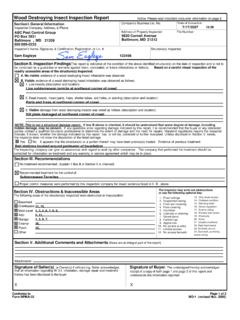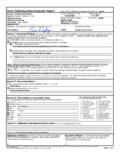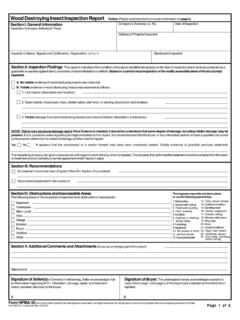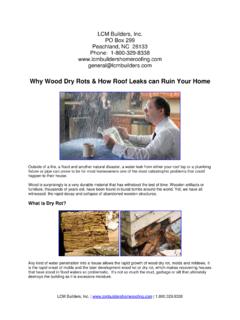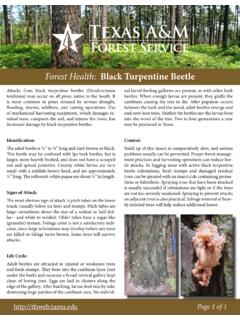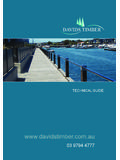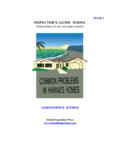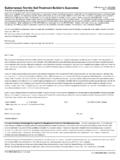Transcription of Borate Pressure Treated Wood FAQs (Frequently …
1 What are borates?Borates are naturally occurring compounds of oxygen and boron, one of the 109 elements in the chemist s Periodic borates a new wood preservative?No. Borates are well known and have been used in Southeast Asia, Australia and the United Kingdom, and for over 50 years in New Zealand. The efficacy and performance of borates have also been studied by independent laboratories, universities and government testing facilities around the should Borate Pressure Treated wood be used? Borate Pressure Treated wood should be used for both new and remedial construction where wood is subject to fungal decay, insect and/or termite should Borate Pressure Treated wood be used?
2 Borate Pressure Treated wood can be used for all interior framing lumber, including sill plate, wall studs, ceiling joists, trusses and millwork, for plywood cladding and flooring, and for any other interior wood components used above ground and out of contact with liquid used in a weather protected exterior environment, Borate Pressure Treated wood must be continuously and properly protected with a minimum of one coat of primer and two coats of exterior paint. (The preservative used in Borate Pressure Treated wood is diffusable.)
3 Continuous contact with liquid water or use in an exterior environment without adequate coating can cause the preservative to leach out of the wood, thereby not providing adequate protection against decay and insect attack).What makes borates effective as a wood preservative?Although low in toxicity to mammals, borates are toxic to decay fungi and a broad spectrum of wood-destroying insects, including carpenter ants, wood-boring beetles and subterranean termites, including the Formosan subterranean termite at the kg/m3 (B2O3) retention is Borate Pressure Treated wood produced?
4 Lumber and plywood are Pressure Treated with Disodium Octaborate Tetrahydrate (or DOT), an odourless and colourless preservative. The preservative is applied as an aqueous solution, using a vacuum/ Pressure process that forces the preservative into the wood under Pressure . Following the vacuum/ Pressure treating cycle, the wood product is stored in a controlled environment and may remain for up to two weeks to allow the boron to diffuse further into the wood. Depending on the end use, the Borate Pressure Treated wood may also be dried after treatment.
5 March 2010 Borate Pressure Treated WoodFAQs ( frequently Asked Questions )Important Information Job site storage intended for interior use only store off the ground and cover to protect from water and allow for ventilation. During construction if the wood should become wet it should be allowed to dry before being covered or enclosed. Do not burn Pressure Treated wood. Wear a dust mask and goggles when cutting or sanding wood. Wear gloves when working with wood. Do not use preserved wood as mulch. Some preservative may migrate from the Treated wood into soil/water or may dislodge from the Treated wood surface upon contact with skin.
6 Wash exposed skin areas thoroughly. Fasteners and other hardware must be compliant with building codes. Residential users may dispose of Treated wood scraps and cut offs by ordinary trash collection or burial. Commercial and industrial users of Treated wood should dispose of Treated wood scraps and cut offs in accordance with local, provincial and federal regulations. When products are used in weather protected exterior applications (such as fascia board), it is recommended that the product be continuously protected from direct wetting with a minimum of one coat primer and two coats exterior finish paint/sealer.
7 Always check the label of the finishing product and follow the manufacturer s instructions. During construction, if the wood should become wet it should be allowed to dry before finishing. Apply finishing product to a small exposed test area of your project before finishing the entire project to insure it provides the intended result before proceeding. Mold growth can and does occur on the surface of many products, including untreated and Treated wood, during prolonged surface exposure to excessive moisture conditions.
8 To remove mold from the Treated wood surface, wood should be allowed to dry. Typically, mild soap and water can be used to remove remaining surface mold. For more information visit borates registered as a wood preservative?The preservative used in Borate Pressure Treated wood is registered in many parts of the world: in Canada, under Health Canada s Pest Management Regulatory Agency; in the United States of America under the Environmental Protection Agency; within the United Kingdom and Ireland, under the Control of Pesticides Regulations 1986, the Irish Ministry for Agriculture, Food and Forestry, the British Wood Preserving and Damp-Proofing Association (BWPDA) and British Board of Agr ment (BBA).
9 Wood Treated with borates can conform to: Canadian Standards Association CSA O80 Wood Preservation Standard, Plywood and Lumber; American Wood-Preservers Association AWPA Standard C9 Plywood and C31 Lumber; British Wood Preserving and Damp-proofing Association commodity specifications C5, C8 and C9, Section 7 BWPDA; European Standards, EN 351 and EN 599; British Standards BS 5268, Part 5 and BS 5589; and British Standards, there a strength loss in wood Pressure Treated with borates?There is no significant strength loss when the lumber is properly kiln dried after treatment.
10 Permanent strength loss is a factor only if the lumber is incised. Where there is a need to incise the product an engineer should be consulted prior to precautions are required when storing Borate Pressure Treated wood?As with untreated wood, it is necessary to keep Borate Pressure Treated wood products dry by covering the material or storing the materials under shelter and elevating the material above the ground to allow for air circulation. Sheathing should be covered as soon as practical after installation. If wetted during initial construction, allow materials to properly dry before permanently enclosing with felt, wallboard, special precautions necessary when working with Borate Pressure Treated wood?
